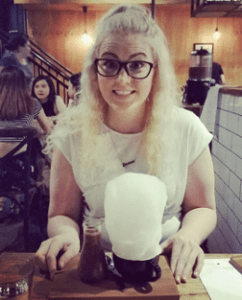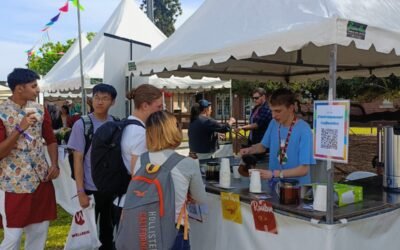As we wished a fond farewell to 2019 and the previous decade, many were eagerly looking forward to 2020. Counting down the seconds, hoping, and praying for a great year; no one could image the disasters laying ahead.
Australia had already been beaten down by the deadly bushfires that burned through the eastern parts of Australia for four months. Then came the flash floods to remind everyone the worst was not over. Whilst this was happening, a new terror was lurking in the background.
COVID-19.
This deadly SARS-like virus quietly snuck into Australia and would devastate not only the everyday lives of Australians but the economy and various job sectors as well. The first death from COVID-19 declared in Australia was announced on 1st March 2020. Marking the beginning of the next few hard months for all healthcare workers.

Figure One: Registered Nurse Jacinta Hoolahan
One healthcare worker, Jacinta Hoolahan, a registered nurse in Western Sydney, was already dealing with the new work environment.
“Working in the COVID pandemic, especially during the first wave, was quite a surreal experience. Despite nursing for over 3.5 years, the last 6 months turned all that I knew completely upside down,” says Miss Hoolahan.
“All the policies and procedures we were used to following were basically irrelevant and outdated,” continues Miss Hoolahan.
“The hospital was forced to find supplies within Australia as the majority of our stock was sourced from overseas. Each local health district within NSW Health needed to amend their policies and procedures to meet the needs of COVID-19,” Miss Hoolahan continues.
Australia was not the only country facing supply and demand issues with medicinal supplies, PPE, equipment, and medicine. This issue rapidly spread on a global scale, sending the world in short supply just like Australia. Panic buying of essential supplies attributed to this issue, with many Australians rushing to supermarkets and pharmacies.

Figure two: Different styles of fabric face masks.
On 11th March 2020, the World Health Organisation (WHO) characterised that the COVID-19 virus was now a global pandemic due to several factors. These noted factors include the distressing levels of spread and severity, along with the unnerving global government inaction.
The Australian government first made efforts to slow down the infectious spread in mid-March, encouraging incoming travellers to self-isolate. However, for Jacinta Hoolahan, this was met with disappointment.
“As a worker on the front line, I was quite disappointed with how the government managed the whole situation. I understand that COVID-19 was surrounded by a lot of unknown,” says Miss Hoolahan, expressing her frustration with the government’s response to COVID-19.
“In retrospect, I think Australia should have adopted a similar tactic to New Zealand. A full-blown shut down much earlier on would have prevented an array of community transmission that lead to a huge spike in cases and potentially, preventable deaths,” Miss Hoolahan continues.
Australia went into a nation-wide lockdown in mid-late March, along with the creation of international and national border control measures and social distancing.
However, a rise in mental health issues became apparent as Australians began to feel the ‘lockdown fatigue’. One psychologist, Lillian Makich, has noted an increase in her patient numbers over the past few months.
“There has been an increase overall. I think it is because people do not have their usual distractions available to them such as the gym, movies, social events, even work at usual workplace/ social interactions. Consequently, they have had to face their own issues that have probably been haunting them for a long time, but they managed to avoid with usual, daily distractions,” says Ms Makich.
“For the few first months, we were faced with unexpected shortages in essential items such as hospital equipment, hand sanitizer and even toilet paper, needing to manage in the best way possible to keep both ourselves and the patients safe.”
– Miss Hoolahan
During the height of lockdown, psychology sessions are conducted over the phone or through video calls, immediately replacing face-to-face sessions. Makich participated in this new form during her sessions, as there was no other choice during these challenging times.
“I have had a few telehealth sessions, but mostly I have continued to provide face-to-face sessions,” she continues.
On 29th March 2020, the Australian government introduced mental health packages to help the country during these trying times.
The pressure of her job and the distressing reality she faced with being a healthcare worker placed Miss Hoolahan’s own mental health at risk as she was getting hit with each shift.
“Being seen as an essential worker during a pandemic was accompanied with quite a lot of pressure and stress,” says Miss Hoolahan.
Not only was Miss Hoolahan at risk of exposure to COVID-19 as a frontline worker, but the family she went home to after each shift were also at risk. She was fearful of her mother and grandmother, who was part of the ‘at-risk’ group.
“Taking care of patients and then going home to my family really impacted my mental health. I was constantly living in fear that, despite adhering to the policies and procedures set out by the hospital, I would be that nurse that was asymptomatic, infecting those around me,” says Miss Hoolahan.

Figure Four: Jacinta Hoolahan
“I found myself quite depressed and lonely during this time as all I was doing was working, unable to participate in leisure activities or hanging out with my friends and family as I did not wish to pose a risk to others,” she continues.
Despite cases flattening in NSW by early April, her job was far from over. One COVID-19 patient almost broke Hoolahan after he took a turn for the worst.
“It looked as though he wasn’t going to make it through the night. Our team contacted his family and arranged a face-time phone call,” says Miss Hoolahan.
“Although the patient was unconscious, we were able to hold the phone up so that the family were able to see their family member and say their goodbyes as they were unable to physically attend the hospital.”
“It was absolutely heartbreaking knowing that this person could die, unable to be surrounded by their loved ones.”
– Miss Hoolahan
Despite the stress and heartache of the last few months, Hoolahan remains optimistic for the future of this country. Understanding the hardship Australians have gone through, she admires the resilient Aussie spirit.
“Thank you to the Australian public for your ongoing support of essential, front line workers. We, as a nation, need to continue to work together to fight COVID-19. Be supportive, be careful, be alert and be kind!”



